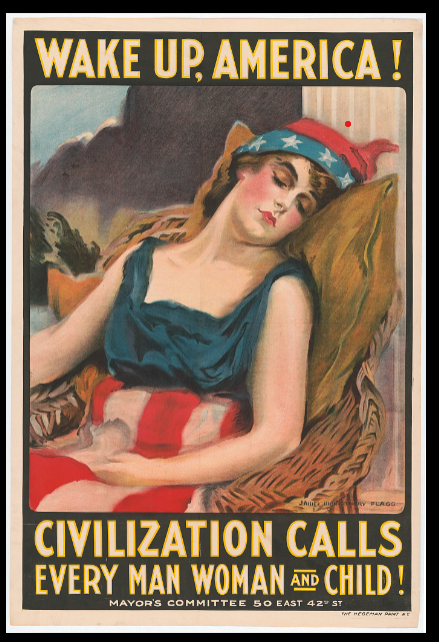The historical source that I am writing about is one of the most important sources that changed America’s course of direction. It was created by James Flagg in 1917. In the cartoon, it shows a famous actress who symbolizes America and the freedom this country has, but she is sleeping. She is shown to be proudly representing America by being very patriotic as she is wearing red, white, and blue along with the stars and stripes. However, she is asleep even in the midst of the chaos in the back which can be seen by the black smoke.
The reason why Flagg created this wonderous cartoon was to simply portray America’s position during world war I as they had stayed neutral for two and a half years. America had not chosen sides or contributed to any of the war efforts going on. The smoke in the back of the cartoon serves as a wake up call to Americans to rethink their position because their power could be of help to the allies. This cartoon was created in 1917, before America entered the war, which meant that it was during world war I which began in 1914 and lasted until 1918. America joined the war in April of 1917 ((Flagg, James Montgomery, Artist. “Wake up America! Civilization calls every man, woman and child!” / James Montgomery Flagg. United States, 1917. N.Y.: The Hegeman Print. Photograph. https://www.loc.gov/item/91726511/.)).
The cartoon shows a woman to appeal to the audience more in regard to the feminine energy by portraying the vulnerability which would connect to the audience. Her sleeping is important to mention as it shows how America could have gone years without entering the war and it would not have made a difference to them. However, there needed to be some kind of wake up call to let them know how bad it was getting on the other side of the world. Civilians submitted a letter to Wilson asking the president to take measures to guarantee American neutrality, arguing on moral and humanitarian grounds ((Chad R. Fulwider. 2016. German Propaganda and U.S. Neutrality in World War I. Columbia, Missouri: University of Missouri. https://search.ebscohost.com/login.aspx?direct=true&AuthType=sso&db=e900xww&AN=1501133&site=eds-live.)). Wilson was keen on maintaining peace which is why he strongly believed that America’s involvement would do the opposite and instigate the war even more. If anything, Germany wanted America to be involved in the war and German Americans would host conferences to discuss the main points of why America was neutral. America was just coming of age in the 1900’s with various cultures and lifestyles being introduced. Society was evolving day by day and it was America’s journey of establishing its identity. Even though Wilson did not want to take a stance on the war, many civilians strongly believed their opinion should be heard as they wanted to be involved in the war.
Another historian, Licursi, talks about how the cultural aspect of America tried to reach its audience by films or memoirs, but none of these messages resonated with some of the audience. With World war I, film studios had the opportunity to present the narrative of an adventure, frontier, or love story against the back drop of a familiar war, one that had personal resonance for many Americans ((Kimberly J. Lamay Licursi. 2018. Remembering World War I in America. Studies in War, Society, and the Military. Lincoln: University of Nebraska Press. https://search.ebscohost.com/login.aspx?direct=true&AuthType=sso&db=e900xww&AN=1690649&site=eds-live)). The media found a great advantage to use war as a topic to appeal to the audience. Going to war was not an easy notion because it meant that America needed to round up all their men and discipline them for their army to establish a strong support system. Many people were not fond of this as they did not want to leave home, but there were people who were also ready to fight. This is why something special as music was an imperative concept that unified the military and gave soldiers a reason to continue fighting even when they did not want to. Even though the CPI (critical program information, a military unit, relating to warfare tactics) was not tasked to control musical matters, the multitude of signifiers embedded in the layers of the song—from the lyrics to the harmonies—promoted war propaganda in various ways; and once in the field, it shaped the men’s experience of the war ((Martin Löschnigg, and Karin Kraus. 2015. North America, Europe and the Cultural Memory of the First World War. Anglistische Forschungen. GERMANY: Universitätsverlag Winter. https://search.ebscohost.com/login.aspx?direct=true&AuthType=sso&db=e000xna&AN=2040749&site=eds-live)). Music played a huge role in destressing any situations under critical conditions. Wilson was adamant on staying neutral, but when they had to join the war, the soldiers needed some distractions. There were many factors as to why civilians were avoiding the war, but it was an awakening for the entire country to be unified at the moment to help their alliances out in the ongoing war.
